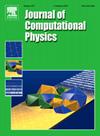守恒双曲多尺度系统的半隐式松弛有限体积格式
IF 3.8
2区 物理与天体物理
Q2 COMPUTER SCIENCE, INTERDISCIPLINARY APPLICATIONS
引用次数: 0
摘要
本文提出了一种基于Jin-Xin松弛法的半隐式松弛方案,用于模拟多尺度双曲型守恒律。它基于将通量函数分解为两个或多个子系统,将所考虑的模型的不同尺度分开,其刚性分量被松弛,从而产生松弛变量上的松弛模型的线性结构。这允许构造一个线性隐式数值格式,其中对流过程被明确地离散化。由于这种线性,离散格式可以在线性解耦的波动型方程中重新表述,从而产生与原始系统相同数量的演化变量。为了获得与尺度无关的数值扩散,在隐式处理项上应用中心通量,而在显式部分上应用经典逆风格式。通过在Toro &;Vázquez-Cendón(2012)欧拉方程的分裂和Fambri(2021)理想MHD方程的分裂,其中通量分为两个,分别为三个子系统。在一维和二维空间上运行文献中的基准测试用例对数值格式的性能进行了评估。本文章由计算机程序翻译,如有差异,请以英文原文为准。
Semi-implicit relaxed finite volume schemes for hyperbolic multi-scale systems of conservation laws
In this paper a new semi-implicit relaxation scheme for the simulation of multi-scale hyperbolic conservation laws based on a Jin-Xin relaxation approach is presented. It is based on the splitting of the flux function into two or more subsystems separating the different scales of the considered model whose stiff components are relaxed thus yielding a linear structure of the resulting relaxation model on the relaxation variables. This allows the construction of a linearly implicit numerical scheme, where convective processes are discretized explicitly. Thanks to this linearity, the discrete scheme can be reformulated in linear decoupled wave-type equations resulting in the same number of evolved variables as in the original system. To obtain a scale independent numerical diffusion, centred fluxes are applied on the implicitly treated terms, whereas classical upwind schemes are applied on the explicit parts. The numerical scheme is validated by applying it on the Toro & Vázquez-Cendón (2012) splitting of the Euler equations and the Fambri (2021) splitting of the ideal MHD equations where the flux is split in two, respectively three sub-systems. The performance of the numerical scheme is assessed running benchmark test-cases from the literature in one and two spatial dimensions.
求助全文
通过发布文献求助,成功后即可免费获取论文全文。
去求助
来源期刊

Journal of Computational Physics
物理-计算机:跨学科应用
CiteScore
7.60
自引率
14.60%
发文量
763
审稿时长
5.8 months
期刊介绍:
Journal of Computational Physics thoroughly treats the computational aspects of physical problems, presenting techniques for the numerical solution of mathematical equations arising in all areas of physics. The journal seeks to emphasize methods that cross disciplinary boundaries.
The Journal of Computational Physics also publishes short notes of 4 pages or less (including figures, tables, and references but excluding title pages). Letters to the Editor commenting on articles already published in this Journal will also be considered. Neither notes nor letters should have an abstract.
 求助内容:
求助内容: 应助结果提醒方式:
应助结果提醒方式:


